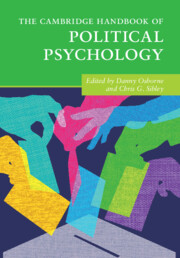Book contents
- The Cambridge Handbook of Political Psychology
- The Cambridge Handbook of Political Psychology
- Copyright page
- Dedication
- Contents
- Figures
- Tables
- Contributors
- Part I Foundations of Political Psychology
- Part II The Politics of Intergroup Attitudes
- Part III Contemporary Challenges to Democracy
- 23 The Political Psychology of Inequality
- 24 How Social Class Influences Political Choices
- 25 Fear and Loathing in American Politics
- 26 Political Extremism
- 27 The Politics of Hate
- 28 Populism
- 29 A Cultural Theory of Autocracy-vs-Democracy
- 30 Psychological Theories Meet the Challenge of Persuading and Mobilising Voters
- 31 Collective Action for Social Change
- 32 Opinion Formation and Polarisation in the News Feed Era
- 33 Conspiracy Theory Belief and Conspiratorial Thinking
- 34 Political Psychology and the Climate Crisis
- 35 The Political Psychology of Cyberterrorism
- 36 Reconciliation in the Aftermath of Collective Violence
- Part IV Diversifying Perspectives in Political Psychology
- Index
- References
33 - Conspiracy Theory Belief and Conspiratorial Thinking
from Part III - Contemporary Challenges to Democracy
Published online by Cambridge University Press: 17 February 2022
- The Cambridge Handbook of Political Psychology
- The Cambridge Handbook of Political Psychology
- Copyright page
- Dedication
- Contents
- Figures
- Tables
- Contributors
- Part I Foundations of Political Psychology
- Part II The Politics of Intergroup Attitudes
- Part III Contemporary Challenges to Democracy
- 23 The Political Psychology of Inequality
- 24 How Social Class Influences Political Choices
- 25 Fear and Loathing in American Politics
- 26 Political Extremism
- 27 The Politics of Hate
- 28 Populism
- 29 A Cultural Theory of Autocracy-vs-Democracy
- 30 Psychological Theories Meet the Challenge of Persuading and Mobilising Voters
- 31 Collective Action for Social Change
- 32 Opinion Formation and Polarisation in the News Feed Era
- 33 Conspiracy Theory Belief and Conspiratorial Thinking
- 34 Political Psychology and the Climate Crisis
- 35 The Political Psychology of Cyberterrorism
- 36 Reconciliation in the Aftermath of Collective Violence
- Part IV Diversifying Perspectives in Political Psychology
- Index
- References
Summary
Conspiracy theories (CTs) and CT belief stem from uncertain, hard to explain, crisis situations, especially when strongly held social and political identities are threatened making people feel anxious, insecure, or out of control. Connected to alarming developments in world politics, CTs are no longer manifestations of extremists and paranoids. As salience increases, scholars continue to examine their antecedents and consequences. This chapter highlights the interdisciplinary roots of the study of CTs and CT belief. It sets the stage with important definitions and measurement challenges, then reviews scholarship on psychological, social, political, and situational factors behind CTs and CT belief. Consequences are vast, allowing for only brief discussion of the spread, persistence, and prevalence related to negative health, social, political, and environmental effects. As it is unlikely that broad weaponisation of CTs or their blaze online will cease in the near future, the chapter concludes by discussing directions for future research.
Keywords
- Type
- Chapter
- Information
- The Cambridge Handbook of Political Psychology , pp. 526 - 545Publisher: Cambridge University PressPrint publication year: 2022
References
- 1
- Cited by

